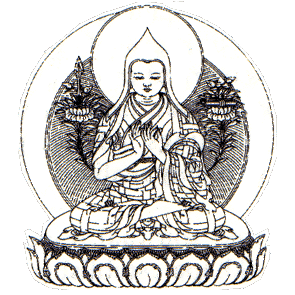A BRIEF HISTORY OF THE GELUG TRADITION
by H.H. Tri Rinpoche Yeshe Dhondup
(the Ninety-ninth Throne-Holder of Tsongkhapa).
|
In this regard, Tsongkhapa saw the study and practice of such Indian classics as the Bodhisattvacaryavatara of Shantideva and the Ratnavali (Precious Garland) of Nagarjuna as highly supportive to an individual's path to Buddhahood. However, in Tsongkhapa's tradition, the Kadam approach is combined with a strong emphasis on the cultivation of an in-depth insight into the doctrine of emptiness as propounded by Nagarjuna and Candrakirti. Tsongkhapa enshrined into a system of learning and contemplation the need to base the above two elements of the path on a whole-hearted wish for liberation, impelled by a genuine sense of renunciation. He called these three elements: renunciation, bodhicitta and the correct view of emptiness, 'the Three Principal Aspects of the Path'. In Tsongkhapa's view, a sound foundation based on these three principles is essential for a successful practice of Vajrayana Buddhism. It is as a result of this emphasis that the Gelug tradition is said to represent a genuine union of sutra and tantra. |
|
Tsongkhapa's written inheritance is enshrined in his collected works, which run into eighteen volumes. These cover an enormously wide spectrum of learning and meditative practices, ranging from explications of the most profound aspects of Highest Yoga Tantra, and the Madhyamaka philosophy of emptiness, to the minute enumeration and analysis of the rules and precepts of a fully ordained monk. In terms of meditative traditions, Tsongkhapa became the master holder of the three main classical Indian lineages of the Mahayana Buddhist path. He inherited the lineage of Rgya chen spyod brand (The Vast Practice), stemming from the Buddha Shakyamuni through to Maitreya; the lineage of Zab mo Ita brayed (The Profound View), which came from the Buddha Shakyamuni through to Manjushri and onto Nagariuna; and was also the master of the lineage of Nyams Men byin rlabs brayed (The Inspirational Lineage of Realisation), which came from Vairadhara through the various lineages of Tantric practices. Through Lama Tsongkhapa these three lineages merged into a single major lineage. Additionally, in Gelug there are also several important transmissions known as Dag snang, (The close lineage of pure vision). Teachings belonging to this category are based on profound mystical experiences of highly realised meditation masters. After a long, devoted and inspired spiritual training, studying with many of the great masters of his time, Tsongkhapa established Ganden monastery to the east of Lhasa, in 1409. Ganden very quickly became a foremost centre of Buddhist philosophical studies attracting students and scholars from all parts of Tibet. The followers of Tsongkhapa who gathered at Ganden, (also known as Geden), later became known as Gelugpa, those from the Geden school. Among Tsongkhapa's foremost disciples were Gyaltsab We (1364-1431); Khedrup Gelek Pelsang (1385-1438); and the First Dalai Lama, Gedun Drup (1391-1474). Following the establishment of Ganden monastery, many other monastic institutions were founded by his principal disciples. Jamyang Choje Tashi Palden (1379-1449) founded Drepung Monastery, reputed to be the largest monastery in the world before 1959. Jamchen Choje Shakya Yeshe (1354-1435) established Sera monastery. The first Dalai Lama founded Tashilhunpo monastery, in Tsang province. Subsequent generations also saw great luminaries who contributed to the flourishing of Lama Tsongkhapa's tradition. These include such masters as the successive Dalai Lamas and Panchen Lamas, Kachen Yeshe Gyaltsen (1713-1793), Gungthang Tenpai Donme (1762-1823), Ngulchu Dharma Bhadra (1772-1851), and more recently the great Phabongkha Dechen Nyingpo (1878-1941). It is through the establishment of the major monastic universities, and also through the noble contribution of these great masters, that the Gelug tradition eventually became the most pervasively established Buddhist school of Tibet. H.H. Tri Rinpoche Yeshe Dhondup Mundgod, India |
[Related links] [Back]
 The Gelug tradition evolved into a fully independent school of Tibetan
Buddhism towards the end of the fourteenth century, A.D. The founder of
the tradition, the great philosopher saint of Tibet, Tsongkhapa
(1357-1419), popularly known as We Rinpoche, was a great admirer of the
Kadam tradition of the celebrated eleventh century Indian master Atisha
and his chief Tibetan disciple, Dromtonpa. Tsongkhapa was particularly
attracted by the Kadam's emphasis on the Mahayana principles of
universal compassion and altruism, valuing these qualities not only as
a spiritual orientation, but more importantly, as a way of life.
The Gelug tradition evolved into a fully independent school of Tibetan
Buddhism towards the end of the fourteenth century, A.D. The founder of
the tradition, the great philosopher saint of Tibet, Tsongkhapa
(1357-1419), popularly known as We Rinpoche, was a great admirer of the
Kadam tradition of the celebrated eleventh century Indian master Atisha
and his chief Tibetan disciple, Dromtonpa. Tsongkhapa was particularly
attracted by the Kadam's emphasis on the Mahayana principles of
universal compassion and altruism, valuing these qualities not only as
a spiritual orientation, but more importantly, as a way of life.